Linear Radical Additions-Coupling Polymerization (LRAsCP): Model, Experiment and Application
Abstract
:1. Introduction
2. Theoretical Analysis of LRAsCP
2.1. General Process of LRAsCP
2.2. The Number-Distribution Functions of MBP
2.3. The Structural Parameters of MBP
3. Discussion on Theoretical Predictions of LRAsCP
3.1. Numbers and Fractions of MBPs (NMBP and FMBP)
3.2. The Number-Average Degree of Polymerization in Terms of X (DPn)
3.3. The Number-Average Molar Mass of Total MBPs (Mn)
3.4. The Average Number of Blocks per MBP (NK)
3.5. The Second-Step Polymerization
3.5.1. Free BFI and AA-Type MBP
3.5.2. DPn,co of MBcP
4. Experimental Study
4.1. Homopolymerization of Styrene
4.2. Two-Step LRAsCP
4.3. Determination of ϕ of Different Monomers
5. Conclusions
6. Experimental Section
Supplementary Materials
Author Contributions
Funding
Institutional Review Board Statement
Data Availability Statement
Conflicts of Interest
Abbreviations
| Abbreviation/symbol | Definition |
| A, A0 | the concentration and initial concentration of monomer |
| B(M)FI | bi(mono)functional initiator |
| MB(c)P | multiblock (co)polymer |
| C | the conversion of monomer |
| f | the functionality of MBP |
| FAA, FIA, FIAI | the molar fraction of three types of MBPs |
| Mn | the number-average molar mass of MBP prepared by BFI |
| Mn,0 | the apparent number-average molar mass |
| mA | the molar mass of monomer A |
| NAA, NIA, NIAI | the number of three types of MBPs |
| NK | the average number of blocks per MBP |
| NK,GPC | the average number of blocks per MBP estimated by GPC |
| the total number of MBPs | |
| Nv | the number of kinetic chains per MBP |
| , , | the number-distribution functions of different kinds of MBPs |
| q | the extent of initiation of functional group |
| W | the weight fraction of MBP |
| X, X0 | residual fragment of BFI, the concentration and initial concentration of BFI |
| DPn | the number-average degree of polymerization in terms of X |
| DPn,GPC | DPn estimated by molar mass of MBP (GPC) |
| DPn,co | DPn of MBcP |
| δ | the molar fraction of small radicals |
| θ | the molar fractions of macroradicals |
| ϕ | termination factor |
| ν | kinetic chain length |
References
- Qiang, X.; Chakroun, R.; Janoszka, N.; Groeschel, A.H. Self-Assembly of Multiblock Copolymers. Isr. J. Chem. 2019, 59, 945–958. [Google Scholar] [CrossRef]
- Steube, M.; Johann, T.; Barent, R.D.; Mueller, A.H.E.; Frey, H. Rational design of tapered multiblock copolymers for thermoplastic elastomers. Prog. Polym. Sci. 2022, 124, 101488. [Google Scholar] [CrossRef]
- Luo, Y.; Guo, Y.; Gao, X.; Li, B.-G.; Xie, T. A General Approach Towards Thermoplastic Multishape-Memory Polymers via Sequence Structure Design. Adv. Mater. 2013, 25, 743–748. [Google Scholar] [CrossRef]
- Self, J.L.; Zervoudakis, A.J.; Peng, X.; Lenart, W.R.; Macosko, C.W.; Ellison, C.J. Linear, Graft, and Beyond: Multiblock Copolymers as Next-Generation Compatibilizers. JACS Au 2022, 2, 310–321. [Google Scholar] [CrossRef]
- Constantinou, A.P.; Sam-Soon, N.F.; Carroll, D.R.; Georgio, T.K. Thermoresponsive Tetrablock Terpolymers: Effect of Architecture and Composition on Gelling Behavior. Macromolecules 2018, 51, 7019–7031. [Google Scholar] [CrossRef]
- Bates, F.S.; Hillmyer, M.A.; Lodge, T.P.; Bates, C.M.; Delaney, K.T.; Fredrickson, G.H. Multiblock Polymers: Panacea or Pandora’s Box? Science 2012, 336, 434–440. [Google Scholar] [CrossRef]
- Beyer, V.P.; Kim, J.; Becer, C. R. Synthetic approaches for multiblock copolymers. Polym. Chem. 2020, 11, 1271–1291. [Google Scholar] [CrossRef]
- Tang, X.; Fan, X.; Chen, X.; Zhou, Q. Progress of Atom Transfer Radical Polymerization (ATRP) Applied to the Synthesis of Multiblock Copolymers. Polym. Bull. 2006, 6, 36–43. [Google Scholar]
- Clothier, G.K.K.; Guimaraes, T.R.; Thompson, S.W.; Rho, J.Y.; Perrier, S.; Moad, G.; Zetterlund, P.B. Multiblock copolymer synthesis via RAFT emulsion polymerization. Chem. Soc. Rev. 2023, 52, 3438–3469. [Google Scholar] [CrossRef]
- Gringolts, M.L.; Denisova, Y.I.; Finkelshtein, E.S.; Kudryavtsev, Y.V. Olefin metathesis in multiblock copolymer synthesis. Beil. J. Org. Chem. 2019, 15, 218–235. [Google Scholar] [CrossRef]
- Diaz, C.; Mehrkhodavandi, P. Strategies for the synthesis of block copolymers with biodegradable polyester segments. Polym. Chem. 2021, 12, 783–806. [Google Scholar] [CrossRef]
- Steube, M.; Johann, T.; Galanos, E.; Appold, M.; Ruettiger, C.; Mezger, M.; Gallei, M.; Müller, A.H.E.; Floudas, G.; Frey, H. Isoprene/Styrene Tapered Multiblock Copolymers with up to Ten Blocks: Synthesis, Phase Behavior, Order, and Mechanical Properties. Macromolecules 2018, 51, 10246–10258. [Google Scholar] [CrossRef]
- Gleede, T.; Rieger, E.; Blankenburg, J.; Klein, K.; Wurm, F.R. Fast Access to Amphiphilic Multiblock Architectures by the Anionic Copolymerization of Aziridines and Ethylene Oxide. J. Am. Chem. Soc. 2018, 140, 13407–13412. [Google Scholar] [CrossRef] [PubMed]
- Tanaka, J.; Gurnani, P.; Cook, A.B.; Haekkinen, S.; Zhang, J.; Yang, J.; Kerr, A.; Haddleton, D.M.; Perrier, S.; Wilson, P. Microscale synthesis of multiblock copolymers using ultrafast RAFT polymerisation. Polym. Chem. 2019, 10, 1186–1191. [Google Scholar] [CrossRef]
- Nishimura, S.-n.; Higashi, N.; Koga, T. Facile Synthesis of Multiblock Copolymers Containing Sequence-Controlled Peptides and Well-Defined Vinyl Polymers by Nitroxide-Mediated Polymerization. Chem. A Eur. J. 2017, 23, 15050–15058. [Google Scholar] [CrossRef]
- Kuroki, A.; Martinez-Botella, I.; Hornung, C.H.; Martin, L.; Williams, E.G.L.; Locock, K.E.S.; Hartlieb, M.; Perrier, S. Looped flow RAFT polymerization for multiblock copolymer synthesis. Polym. Chem. 2017, 8, 3249–3254. [Google Scholar] [CrossRef]
- Kerr, A.; Hartlieb, M.; Sanchis, J.; Smith, T.; Perrier, S. Complex multiblock bottle-brush architectures by RAFT polymerization. Chem. Commun. 2017, 53, 11901–11904. [Google Scholar] [CrossRef]
- Engelis, N.G.; Anastasaki, A.; Nurumbetov, G.; Truong, N.P.; Nikolaou, V.; Shegiwal, A.; Whittaker, M.R.; Davis, T.P.; Haddleton, D.M. Sequence-controlled methacrylic multiblock copolymers via sulfur-free RAFT emulsion polymerization. Nat. Chem. 2017, 9, 171–178. [Google Scholar] [CrossRef]
- Anastasaki, A.; Oschmann, B.; Willenbacher, J.; Melker, A.; Van Son, M.H.C.; Truong, N.P.; Schulze, M.W.; Discekici, E.H.; McGrath, A.J.; Davis, T.P.; et al. One-Pot Synthesis of ABCDE Multiblock Copolymers with Hydrophobic, Hydrophilic, and Semi-Fluorinated Segments. Angew. Chem. Int. Ed. 2017, 56, 14483–14487. [Google Scholar] [CrossRef]
- Aksakal, R.; Resmini, M.; Becer, C.R. Pentablock star shaped polymers in less than 90 minutes Via aqueous SET-LRP. Polym. Chem. 2016, 7, 171–175. [Google Scholar] [CrossRef]
- Gody, G.; Barbey, R.; Danial, M.; Perrier, S. Ultrafast RAFT polymerization: Multiblock copolymers within minutes. Polym. Chem. 2015, 6, 1502–1511. [Google Scholar] [CrossRef]
- Zhang, C.; Wang, Q. Degradable Multisegmented Polymers Synthesized by Consecutive Radical Addition-Coupling Reaction of alpha,omega-Macrobiradicals and Nitroso Compound. J. Polym. Sci. Part A Polym. Chem. 2011, 49, 612–618. [Google Scholar] [CrossRef]
- Zhu, Q.; Wang, Q. Thermodegradable multisegmented polymer synthesized by consecutive radical addition-coupling reaction of α, ω-macrobiradicals and dithioester. J. Polym. Sci. Part A Polym. Chem. 2012, 50, 2029–2036. [Google Scholar] [CrossRef]
- Tao, F.; Li, J.; Wang, Q. Aqueous radical addition-coupling polymerization for the synthesis of hydrophilic periodic polymer. RSC Adv. 2014, 4, 53253–53256. [Google Scholar] [CrossRef]
- Tao, F.; Wang, Q. Aqueous radical addition-coupling polymerization using a nitroso benzene/cyclodextrin complex for the synthesis of a hydrophilic periodic polymer. RSC Adv. 2015, 5, 46007–46010. [Google Scholar] [CrossRef]
- Zhu, X.; Wang, Z.; Liu, J.; Min, X.; Wang, T.; Fan, X. A New Strategy to Synthesize α,ω-Dihydroxy Multiblock Copolymers via CpRu(CH3CN)3 PF6/Quinaldic Acid Catalyst. Macromol. Rapid Commun. 2019, 40, 1900135. [Google Scholar] [CrossRef]
- Beyer, V.P.; Cattoz, B.; Strong, A.; Phillips, D.J.; Schwarz, A.; Becer, C. R. Fast track access to multi-block copolymers via thiol-bromo click reaction of telechelic dibromo polymers. Polym. Chem. 2019, 10, 4259–4270. [Google Scholar] [CrossRef]
- Cianga, I.; Yagci, Y. First polyrecombination reaction via atom transfer radical coupling (ATRC), a new way for the synthesis of poly(p-xylylene). Des. Monomers Polym. 2007, 10, 575–584. [Google Scholar] [CrossRef]
- Durmaz, Y.Y.; Aydogan, B.; Cianga, I.; Yagci, Y. The Use of Atom Transfer Radical Coupling Reactions for the Synthesis of Various Macromolecular Structures. Polym. Prepr. 2008, 49, 382–383. [Google Scholar]
- Wang, C.H.; Song, Z.Y.; Deng, X.X.; Zhang, L.J.; Du, F.S.; Li, Z.C. Combination of ATRA and ATRC for the Synthesis of Periodic Vinyl Copolymers. Macromol. Rapid Commun. 2014, 35, 474–478. [Google Scholar] [CrossRef]
- Liu, Z.; Wang, Q. Radical coupling copolymerization (RCCP) for synthesis of various polymers. Polymer 2016, 100, 56–59. [Google Scholar] [CrossRef]
- Liu, Z.; Wang, Q. Radical coupling polymerization (RCP) for synthesis of various polymers. RSC Adv. 2016, 6, 39568–39572. [Google Scholar] [CrossRef]
- Zhang, C.; Wang, Q. Step-Growth Radical Addition-Coupling Polymerization (RACP) for Synthesis of Alternating Copolymers. Macromol. Rapid Commun. 2011, 32, 1180–1184. [Google Scholar] [CrossRef] [PubMed]
- Zhang, C.; Ling, J.; Wang, Q. Radical Addition-Coupling Polymerization (RACP) toward Periodic Copolymers. Macromolecules 2011, 44, 8739–8743. [Google Scholar] [CrossRef]
- Zhang, C.; Wang, Q. Block copolymers prepared by polymeric radical addition cross-coupling reaction to different double bonds. J. Polym. Sci. Part. A Polym. Chem. 2013, 51, 2817–2823. [Google Scholar] [CrossRef]
- Li, J.; Wang, Q. Radical Addition-Coupling Polymerization with Various Nitroso Compounds. J. Polym. Sci. Part A Polym. Chem. 2014, 52, 810–815. [Google Scholar] [CrossRef]
- Liu, Z.; Wang, Q. Radical addition-coupling polymerization (RACP) of various benzyl-type biradical toward periodic polymers. Polymer 2016, 94, 14–18. [Google Scholar] [CrossRef]
- Ren, L.M.; Li, C.L.; Wang, Q. Non-linear Radical Additions-Coupling Polymerization of Monovinyl Monomers towards Polymer Networks: Theory, Tunability and Heritable Architecture. Chin. J. Polym. Sci. 2022, 40, 1623–1630. [Google Scholar] [CrossRef]
- Gilbert, B.C.; Harrison, R.J.; Lindsay, C.I.; McGrail, P.T.; Parsons, A.F.; Southward, R.; Irvine, D. J. Polymerization of methyl methacrylate using dimanganese decacarbonyl in the presence of organohalides. Macromolecules 2003, 36, 9020–9023. [Google Scholar] [CrossRef]
- Haines, L.I.B.; PoË, A.J. Initiation of Vinyl Polymerization by Manganese Carbonyl and Carbon Tetrachloride. Nature 1967, 215, 699–701. [Google Scholar] [CrossRef]
- Ciftci, M.; Tasdelen, M.A.; Yagci, Y. Sunlight induced atom transfer radical polymerization by using dimanganese decacarbonyl. Polym. Chem. 2014, 5, 600–606. [Google Scholar] [CrossRef]
- Odian, G. Principles of Polymerization, 4th ed.; Wiley & Sons, Inc.: Hoboken, NJ, USA, 2004. [Google Scholar]
- Dewkar, G.K.; Carneiro, P.B.; Hartman, M.C.T. Synthesis of Novel Peptide Linkers: Simultaneous Cyclization and Labeling. Org. Lett. 2009, 11, 4708–4711. [Google Scholar] [CrossRef] [PubMed]
- Arnett, L.M.; Peterson, J.H. Vinyl Polymerization with Radioactive Aliphatic Azobisnitrile Initiators. J. Am. Chem. Soc. 1952, 74, 2031–2033. [Google Scholar] [CrossRef]
- Bamford, C.H.; Jenkins, A.D. Termination Reaction in Vinyl Polymerization: Preparation of Block Copolymers. Nature 1955, 176, 78. [Google Scholar] [CrossRef]
- Bamford, C.H.; Dyson, R.W.; Eastmond, G.C. Studies in network formation. J. Polym. Sci. Part C Polym. Symp. 1967, 16, 2425–2434. [Google Scholar] [CrossRef]
- Bamford, C.H.; Eastmond, G.C.; Whittle, D. Network formation III—Influence of organometallic initiator on network structure. Polymer 1969, 10, 771–783. [Google Scholar] [CrossRef]
- Zammit, M.D.; Davis, T.P.; Haddleton, D.M.; Suddaby, K.G. Evaluation of the mode of termination for a thermally initiated free-radical polymerization via matrix-assisted laser desorption ionization time-of-flight mass spectrometry. Macromolecules 1997, 30, 1915–1920. [Google Scholar] [CrossRef]



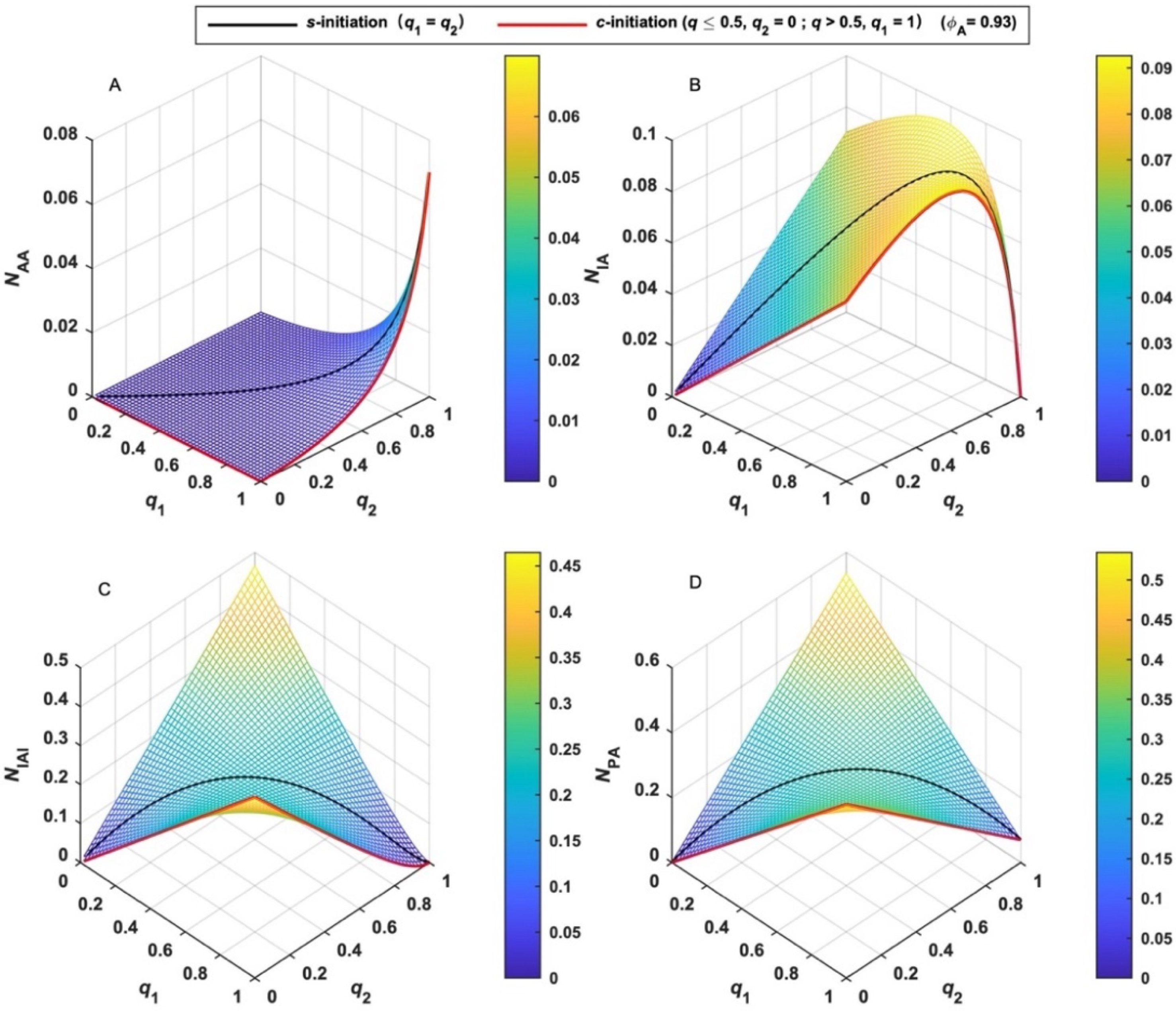
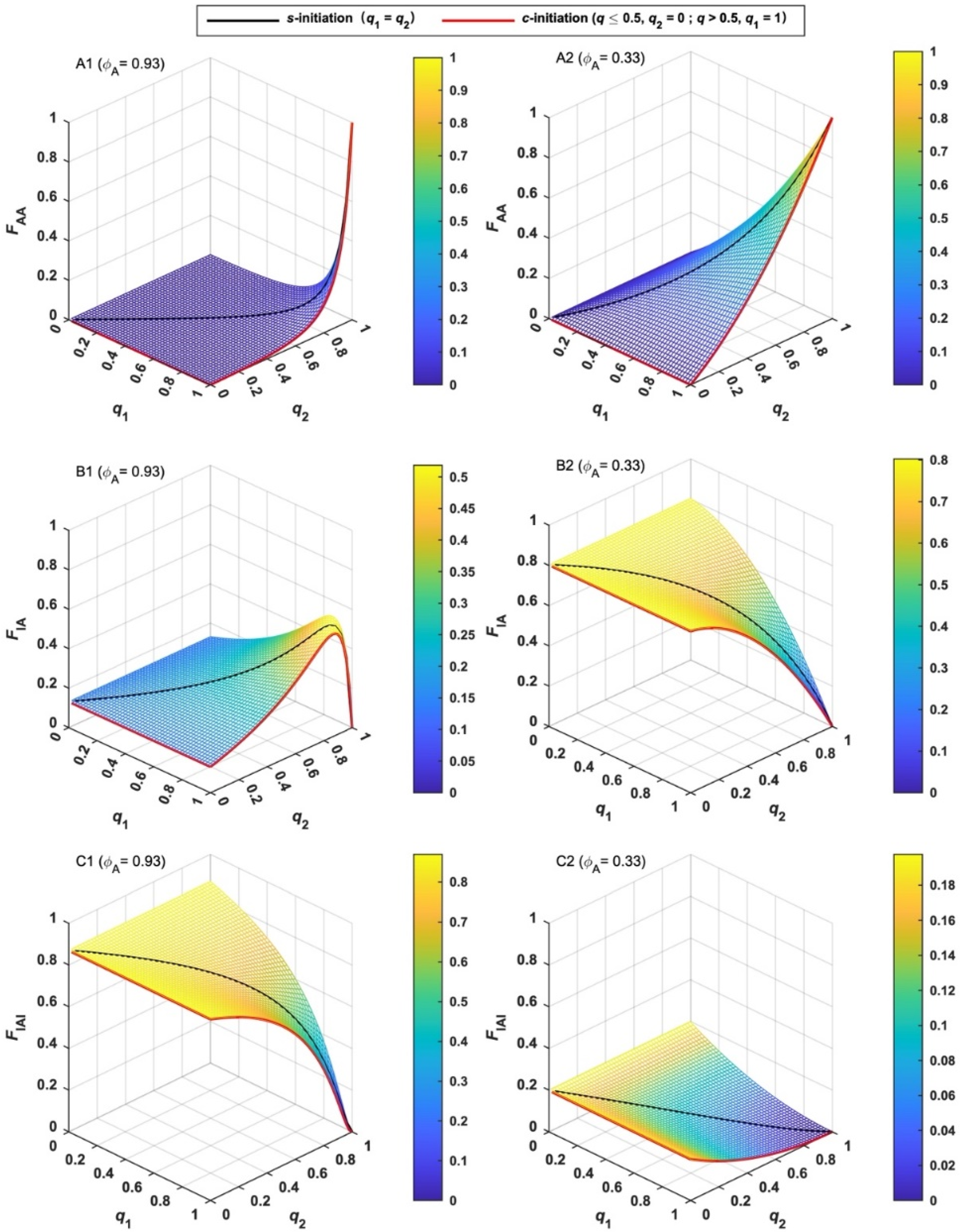
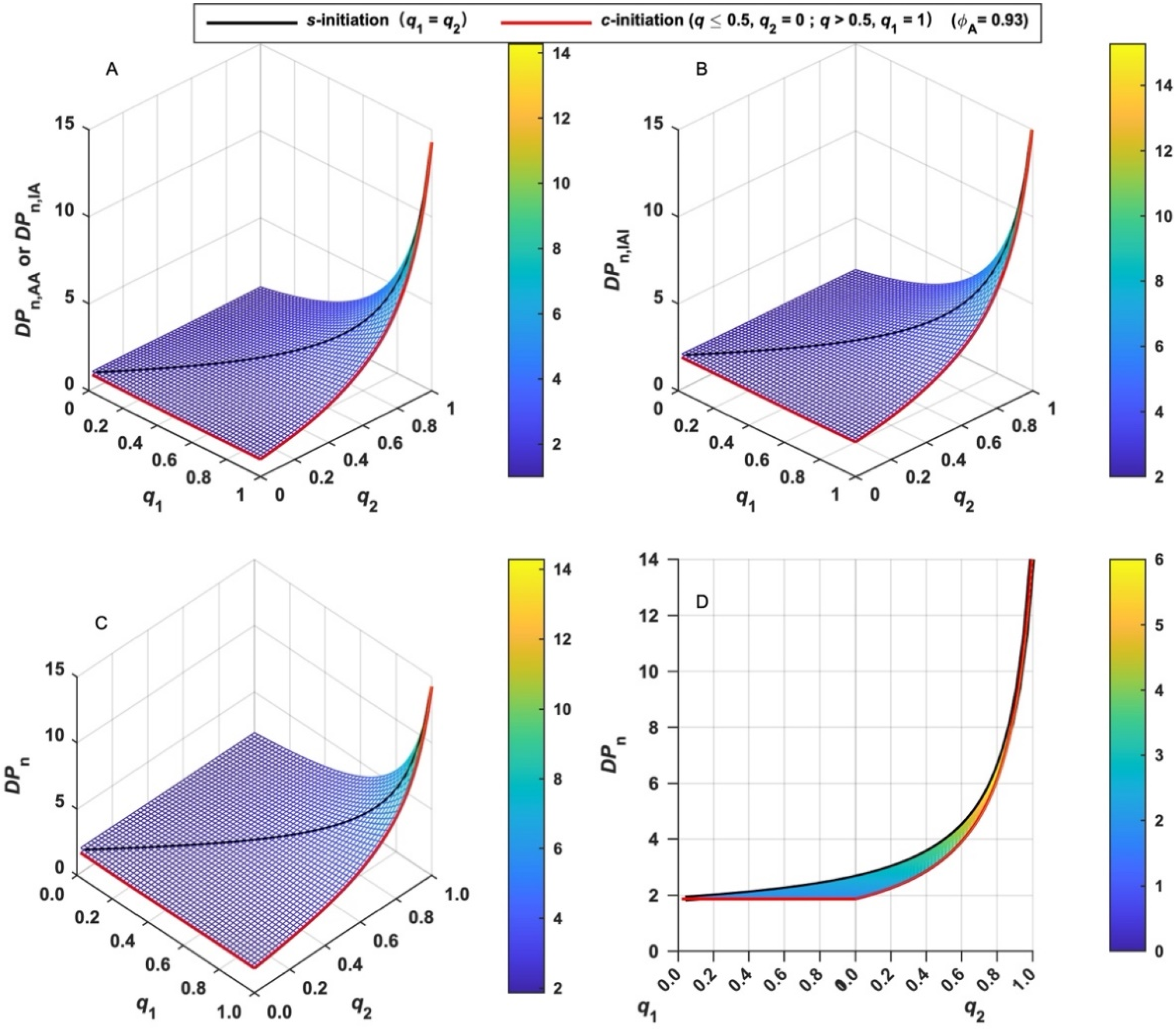
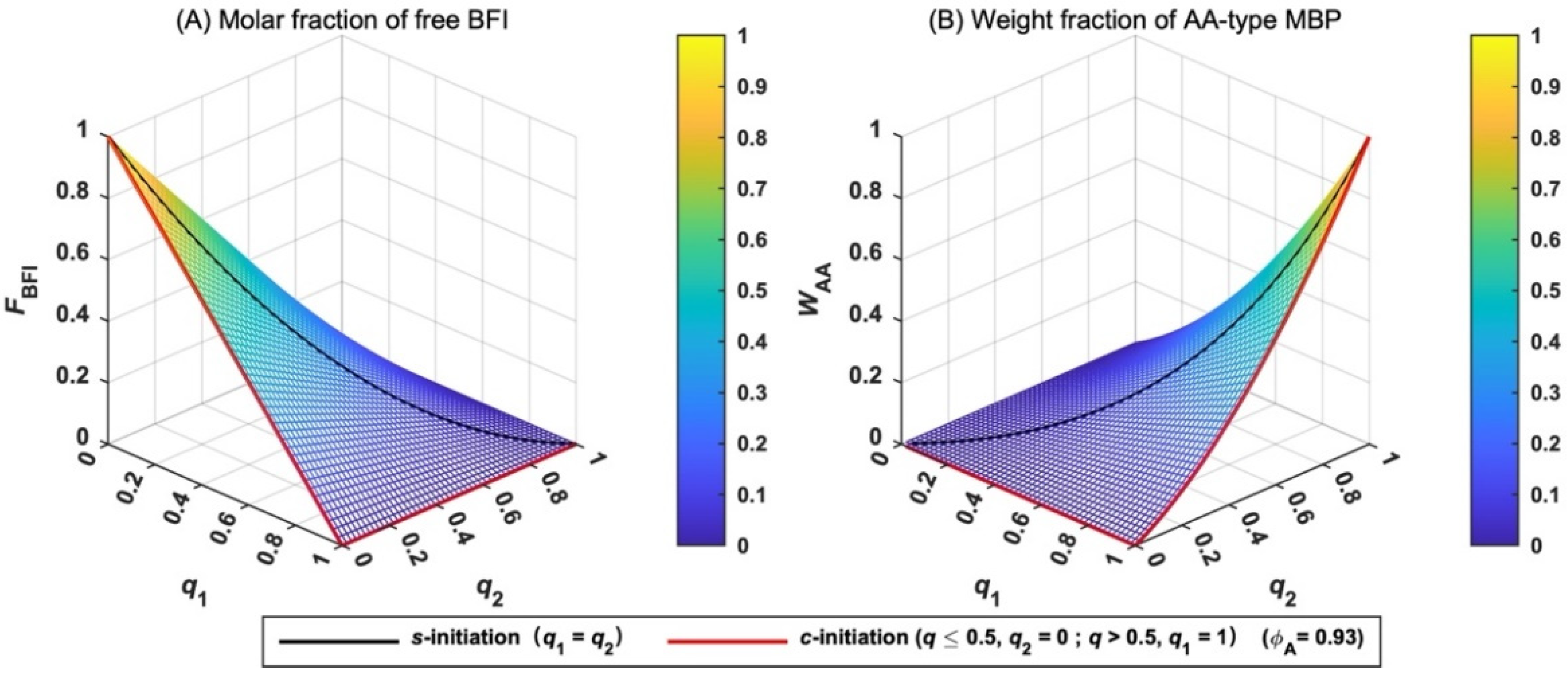
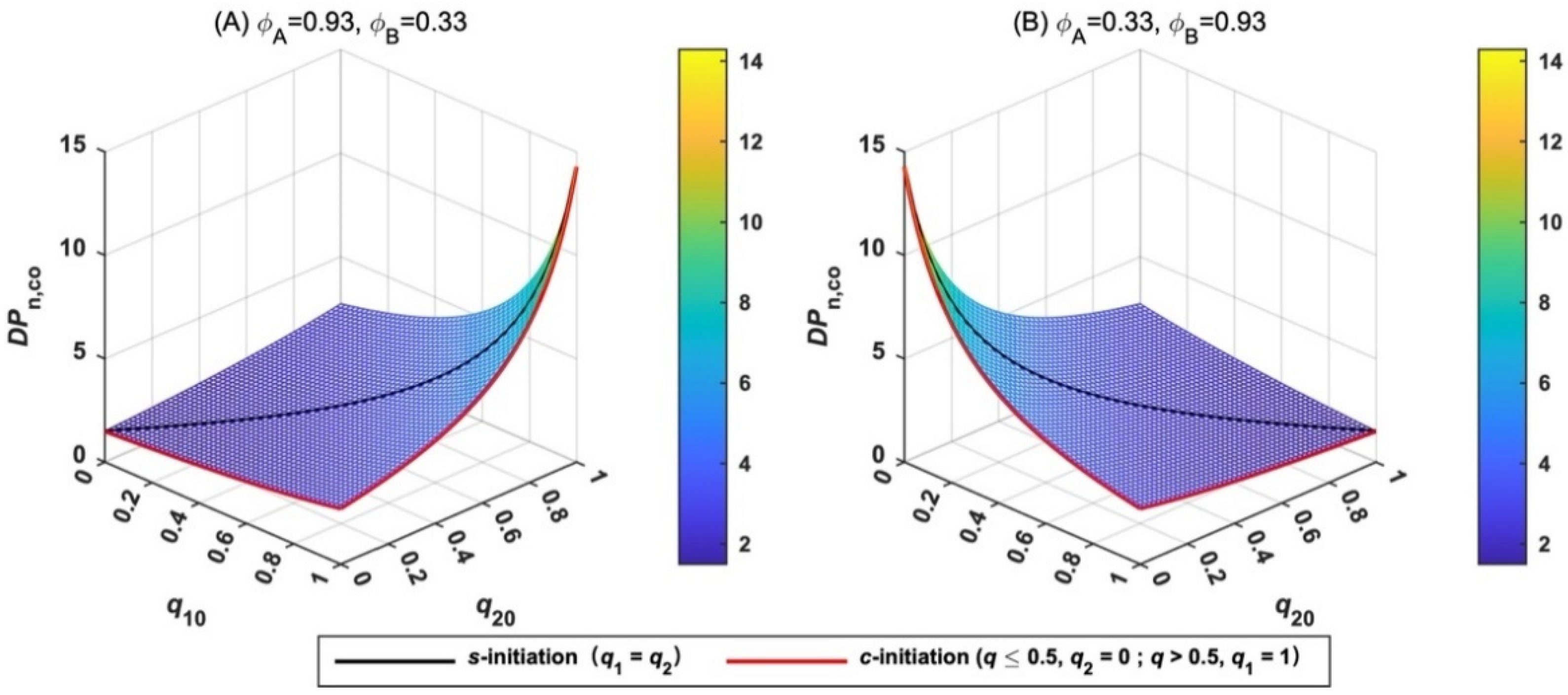
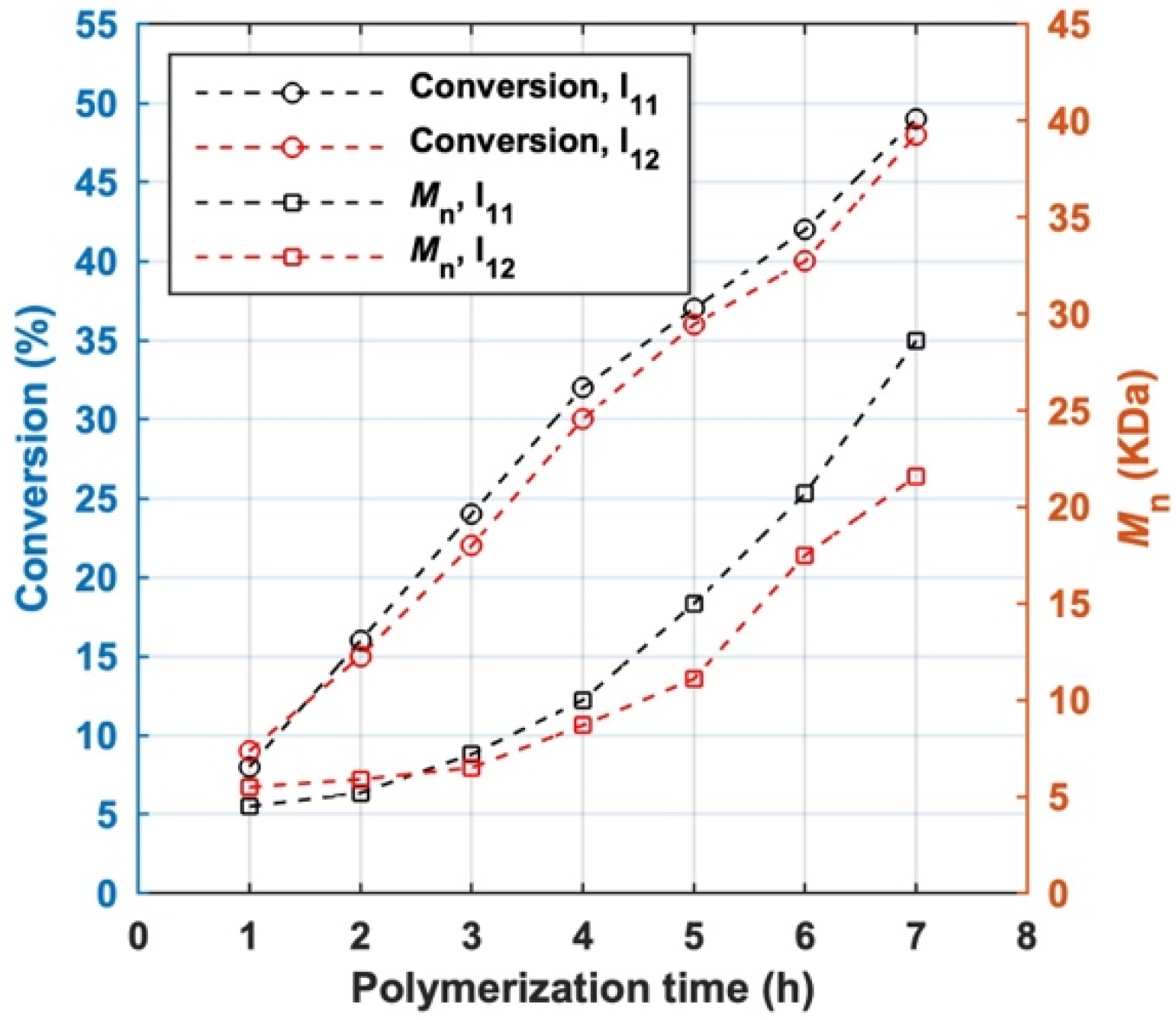


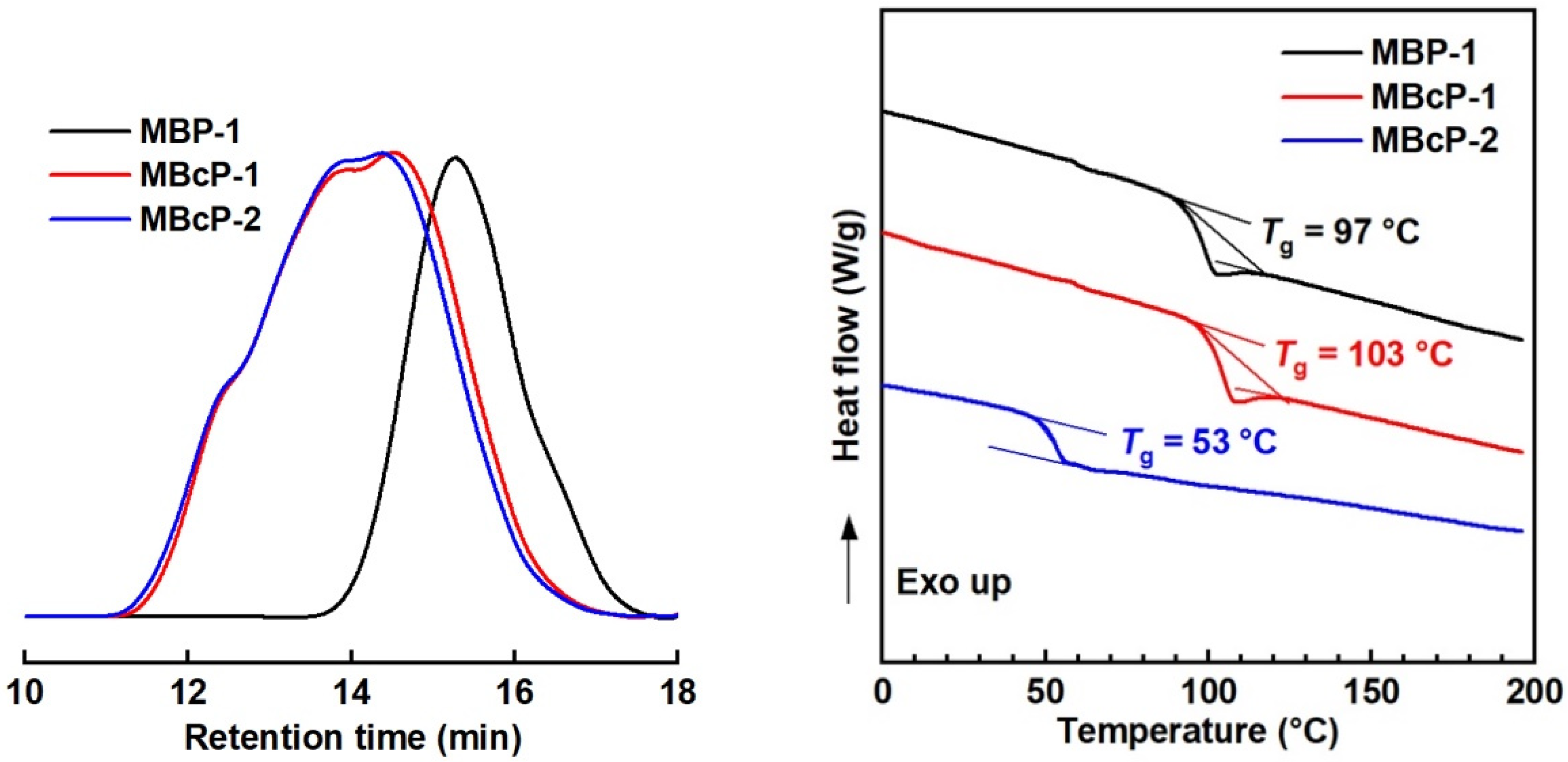
| Parameters | Monoradical | Biradical | Nonradical | Sum | |
|---|---|---|---|---|---|
| (I2XI1•) | (I1XI2•) | (•I1XI2•) | (I2XI1) | ||
| Number of molecule | 1 | ||||
| Fraction of molecule | 1 | ||||
| Number of radical | 0 | ||||
| Fraction of radical | 0 | 1 | |||
Disclaimer/Publisher’s Note: The statements, opinions and data contained in all publications are solely those of the individual author(s) and contributor(s) and not of MDPI and/or the editor(s). MDPI and/or the editor(s) disclaim responsibility for any injury to people or property resulting from any ideas, methods, instructions or products referred to in the content. |
© 2025 by the authors. Licensee MDPI, Basel, Switzerland. This article is an open access article distributed under the terms and conditions of the Creative Commons Attribution (CC BY) license (https://creativecommons.org/licenses/by/4.0/).
Share and Cite
Jiang, Y.; Cao, K.; Wang, Q. Linear Radical Additions-Coupling Polymerization (LRAsCP): Model, Experiment and Application. Polymers 2025, 17, 741. https://doi.org/10.3390/polym17060741
Jiang Y, Cao K, Wang Q. Linear Radical Additions-Coupling Polymerization (LRAsCP): Model, Experiment and Application. Polymers. 2025; 17(6):741. https://doi.org/10.3390/polym17060741
Chicago/Turabian StyleJiang, Yudian, Kun Cao, and Qi Wang. 2025. "Linear Radical Additions-Coupling Polymerization (LRAsCP): Model, Experiment and Application" Polymers 17, no. 6: 741. https://doi.org/10.3390/polym17060741
APA StyleJiang, Y., Cao, K., & Wang, Q. (2025). Linear Radical Additions-Coupling Polymerization (LRAsCP): Model, Experiment and Application. Polymers, 17(6), 741. https://doi.org/10.3390/polym17060741







